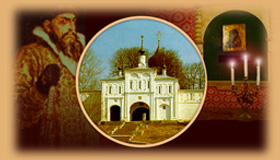Pearls of Russia
Museums and memorial estates
 Museum-reserve "Alexandrovskaya Sloboda"
Museum-reserve "Alexandrovskaya Sloboda"
State museum-reserve "Alexandrovskaya Sloboda" is situated on the territory of Alexandrov Kremlin, the most ancient government residence of Moscow Tsars.
It has been forever remembered as the famous Alexandrovskaya Sloboda, oprichnina capital of Ivan the Terrible.
History
The destiny of Sloboda was determined by the father of Tsar Ivan IV - Great Moscow Prince Vasily III. By his will a magnificent palace was built in Sloboda. Since December, 11, 1513 Alexandrovskaya Sloboda became a home of sovereign, his family and court.
Oprichnina started here and from here Tsar's army went to conquer the free Novgorod. The Alexandrov Kremlin housed the embassies from many countries - Sweden, Denmark, Austria, England, Rech' Pospolitaya. The most important political pacts and trade bargains were signed in its chambers. And from here the first breakthrough to Europe had been made after the many centuries of Russia's isolation and silence.
By Ivan the Terrible's will Sloboda became the largest cultural center of the Russian state. The best architects, icon-painters and musicians lived and worked here. A bookmaking workshop, where they compiled chronicles existed at the Tsar's court, the first Russian Conservatory and the first provincial printing house were set up there.
A lot of events from Ivan IV's personal life are connected with Alexandrovskaya Sloboda. The bride-shows for Tsar himself and later for his son Ivan, resulting in grand weddings, took place there. Ivan the Terrible's mysterious library was lost in Sloboda. The 17-year old history of the oprichnina capital was terminated for Tsar by a terrible drama. In a fit of anger he mortally wounded his son Ivan.
Monuments
The monuments of Alexandrovskaya Sloboda are rare and well-remained old-Russian palace-temple ensemble. The oldest monuments of the ensemble belong to 16th century, a time of significant changes in life of Russian State. The spirit of the century, epoch of formation of autocracy and strengthening of power of Russia has found its reflection in architecture of the royal fortress - Alexandrovskaya Sloboda.
Russian and Italian architects took part in constructing the ensemble. The lay-out of the front part of the fortress and the main buildings of the Russian 'royal palace' are preserved till today.
In the center of the ensemble stands the palace temple - now the Trinity Cathedral. It was built in the beginning of 16th century, the time when the Moscow Great Prince Vasily starts the construction of a luxurious fortified out of town residence in Sloboda. The cathedral is built of white stone and large bricks.
The interior of the cathedral corresponds to the important political events that took place here in the Middle Ages, to the ceremonies in the presence of the Royal Family, to the grand weddings of the fearsome Tsar. The walls, vaults and columns of the cathedral are painted with frescoes, devoted to Our Lady. The cult of Mother of God, who was especially respected in Russia, strengthened the thesis, introduced in 16th century - 'Moscow is the third Rome'. The later renewals in the interior didn't change the initial iconography of 16th century.
The Vasiliyevskiye gates - one of the masterpieces of 14th century Russian decorative art, close the southern portal of the cathedral. The Novgorod craftsmen on the order of archbishop Vasily created the unique monument, produced according to the technique of the fire gilding in 1336.
The architectural dominant of the palace ensemble in Alexandrovskaya Sloboda is the Raspyatskaya church-bell tower. Its special power and rushing up make this architectural monument one of the outstanding works of the Russian art. The Raspyatskaya church-bell tower is rare monument of the hip-roof stone Russian architecture of 16th century. The ancient legend about Nikita, who wanted to fly up as a bird, is connected with it.
On the territory there are two hip-roof stone temples of 16th century. In the Pokrovskaya church, situated not far from the Raspyatskaya church-bell tower, the ancient home temple of the great princes is preserved. The simple and solemn construction, crowned with an octal hip-roof in 16th century used to adjoin to the palace of one of Europe's greatest monarchs - Ivan the Terrible.
The frescoes on the roof of the temple are of special interest. It is the only 16th century hip-roof in Russia painted with various plots.
The monuments of Alexandrovskaya Sloboda have occupied a considerable place in the Russian art of 16th century.
Expositions:
"Alexandrovskaya Sloboda in XVI-XVIII centuries"
"Dining chamber of 16th century in the palace buildings of Tsar Ivan IV"
"Tsar Ivan IV the Terrible in painting"
"Pokrovskaya Church - the home church of the Tsar's palace"
"The treasures of the three centuries"
"The ways of ancient times"
The expositions on different topics take place in the halls of the museum. Both the museum's collections from its stock and the expositions from the other museums of this country and private collections are exhibited.
The stock of the museum was being collected for 75 years. They reflect the glorious, original history and culture of the Mediaeval Aleksandrovskaya Sloboda - the cultural and political center of XVI century Russia. They also give you an idea of the development of the Russian province in XIX century. The collections of XX century tell about the most significant events of the century.
You can make over 25 unusual trips to the past in the museum-national park "Alexandrovskaya Sloboda".
The museum actively participates in the historical-cultural festival "The ancient town, the glorious town" and in the musical festival "Alexandrovskaya Sloboda". These are festive theatrical shows in the open air on the territory of the museum-reserve. Here you can hear Russian church music performed by the museum band 'Svetlolitie' and famous capital actors, win a prize in a contest for the historical costume.
Address: 20 Museum Proezd, Alexandrov, Vladimirskaya obl., Russia, 601600
|